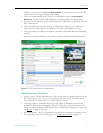
12 © 2009 VBrick Systems, Inc.
download components that are appropriate for your computer. If you agree, these
components are automatically installed and no additional download is necessary for
subsequent access. On Macintosh PCs, Portal Server functionality is the same as in Windows
except that the
Add Video feature is not available. Table 4 shows the stream types supported
for each environment; Table 5 shows the operating systems that are tested and supported.
Note that there are certain performance limitations in Macintosh environments; see the ETV
Portal Server Release Notes for information and recommendations.
Configuring a Macintosh for Tunneled Streams
You may need to perform certain configuration steps on a Macintosh before you can use
QuickTime to view streams tunneled over HTTP from a VOD-W server.
T To configure QuickTime for tunneled streams
1. Launch QuickTime on a Macintosh and click on the
Apple QuickTime player to set focus
on the task bar at the top of the screen.
2. Click
QuickTime Player in the task bar and go to QuickTime Preferences.
3. On the
Advanced tab, click on Transport Setup and then Custom.
4. Check the
Port ID used for the HTTP Transport Protocol. The Port ID must match the
HTTP Tunneling Port set on the Portal Server for the VOD-W server (default = 8000). If
necessary, get this port number from your system administrator. See the VOD-W Admin
Guide for more information.
Linux PCs
If configured with the appropriate components, Linux PCs running Fedora or Red Hat
(on Firefox) can play MPEG, WM, and H.264 streams. However, the Portal Server must
download Linux components to each-end user desktop before any streams will play. This should
only be performed by a system administrator. When you access the Portal Server for the first
time, you will see a message in the embedded player window indicating that the appropriate
plugins are not installed. See "Installing Linux Components" in the Portal Server Release Notes
for detailed instructions. On Linux PCs, Portal Server functionality is the same as in
Windows except that the
Add Video feature is not available. Table 4 shows the stream types
supported for each environment; Table 5 shows the operating systems that are tested and
supported. Note that there are certain performance limitations in Linux environments; see
the ETV Portal Server Release Notes for information and recommendations.
Table 4. Supported Stream Types – Macintosh and Linux
† Closed captions are not currently supported on H.264 streams.
Environment Supported Streams Closed Captions †
Macintosh Safari – MPEG-1, MPEG-2,
MPEG-4, WM, H.264.
Supported for MPEG-1/MPEG-2 streams,
and for MPEG-4 and WM with VBrick
plugin.
Firefox – MPEG-1, MPEG-2,
MPEG-4, WM, H.264.
Supported for MPEG-1/MPEG-2 streams,
and for MPEG-4 and WM with VBrick
plugin.
Linux Firefox – MPEG-1, MPEG-2,
MPEG-4, WM, H.264.
Supported for MPEG-1, MPEG-2,
MPEG-4, and WM streams.


















